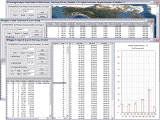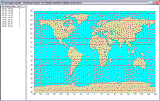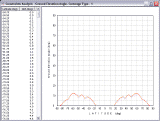Periodic Coverage Analysis Module
The Periodic Coverage Analysis
module allows you to undertake statistical
analyses of visibility intervals for user-defined
geographical regions. You can supply the exact
locations of points and specify latitude
bounds, or you can use the 2D map to define custom
regions. The module determines visibility intervals
for each point of the coverage grid and creates an
interactive report that shows the revisit time
(max/min, average), coverage
time, number of gaps, and total coverage duration (%)
measured over the entire simulation interval, etc. You can determine visibility intervals
when the specified number of satellites is available
to grid points. The results can be
grouped by latitude and by region. The report
includes a histogram showing the distribution of
durations of visibility intervals (or gaps) for a selected set of points.
|

|
Continuous Coverage Analysis Module
The Continuous Coverage Analysis
module allows you to determine, for a given constellation, the minimum number of satellites that
will be available at all times to each point at given latitudes. An analyzed constellation
can include any combination of satellites or groups
of satellites with the same orbit altitude and inclination. Each such subconstellation can be analyzed separately. You can specify individual access constraints for any group of satellites. The module generates the Coverage by Latitude
tabular report and displays the results of analyses on a world map, with
graphics depicting the various levels of coverage.
|

|
Constraints Analysis Module
The Constraints Analysis module allows you to determine
latitude-dependent values of the minimum ground elevation angle,
maximum satellite sensor's field-of-view, and maximum ground station to
satellite propagation range, all of which have to be maintained by the
generated constellation to provide the desired type of
continuous coverage (single, double, triple, etc.) at specified latitudes.
|

|
|